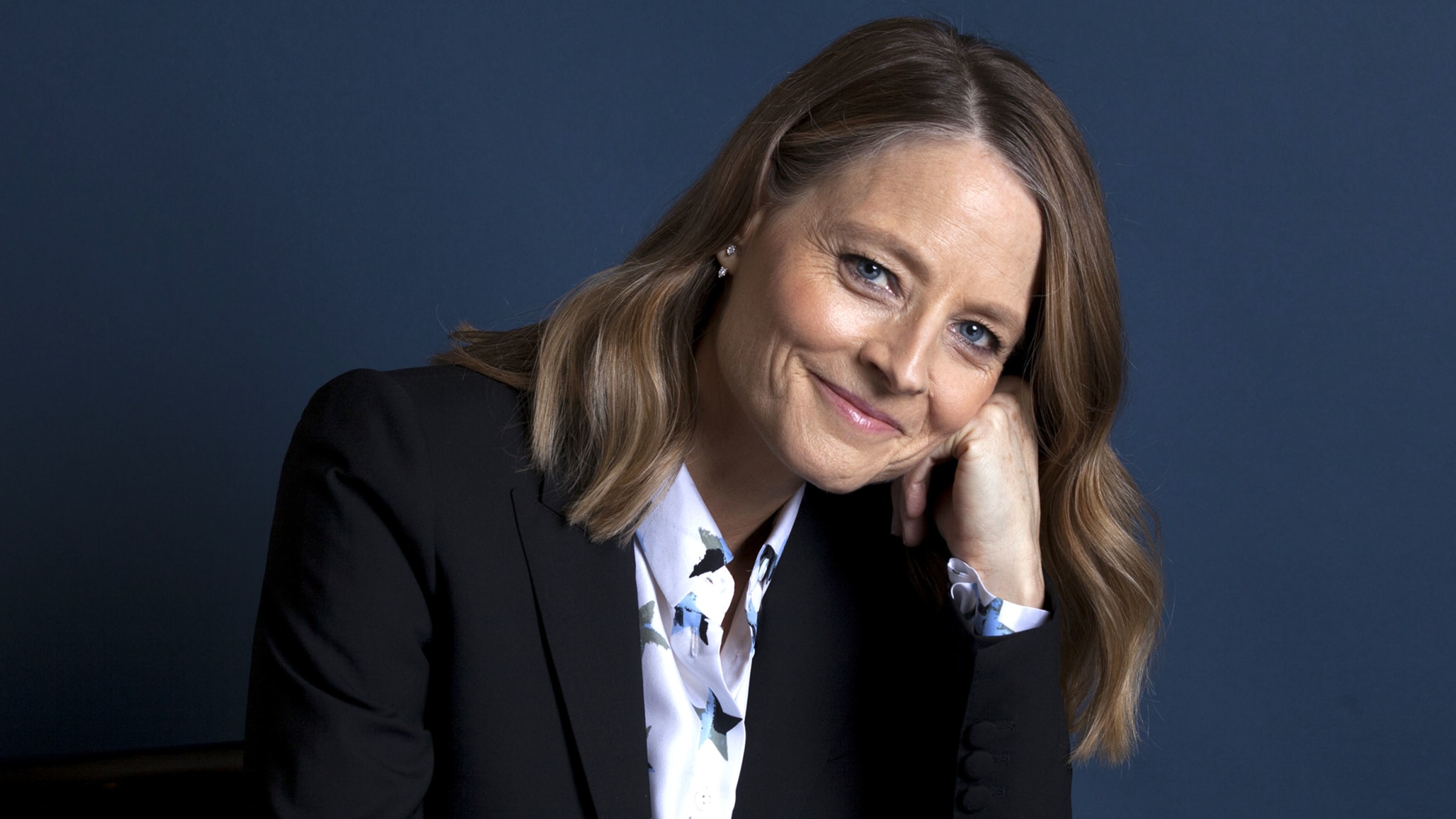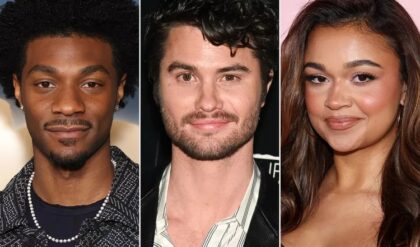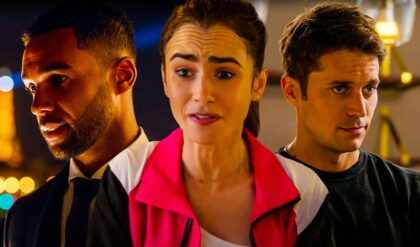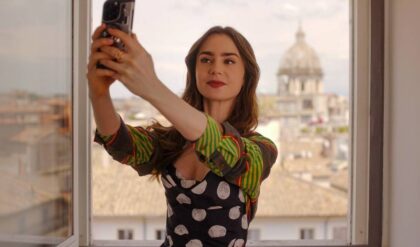With two Oscars, the actress-turned-director is about to debut her not- exactly-mainstream movie (“The Beaver”) with a not-exactly-perfect star (Mel Gibson).
Jodie Foster is sick, really sick. Sick of being away from home for the past two months; sick of the grueling schedule she’s maintained in Paris on Roman Polanski’s Carnage; and physically, painfully sick from what she thinks is strep throat, which she’s been battling for much of the week.
“I don’t know if it’s strep throat; I just have never experienced this before in my life,” she says, pallid. “I was up all last night — I went to sleep between 6 a.m. and 10 a.m. When I swallow, it really hurts. But I’ve got to work Monday, and all my scenes are yelling.”
She’s unlikely to find any relief in the days ahead. With less than 72 hours before she flies to Austin’s South by Southwest festival on March 16 to unveil her new movie, The Beaver — about a middle-aged executive who communicates through a glove puppet — she still has to pack her bags and complete two days of reshoots on the behind-schedule Carnage.
Then she’ll have to field a volley of questions about Mel Gibson, who stars opposite her in the $21 million Beaver, Foster’s third venture as helmer. At a point in her career when she might have hoped audiences would rediscover her as a filmmaker, she’s grappling instead with a media firestorm — “my second,” she notes wryly, following the assassination attempt on President Reagan in 1981.

If this isn’t enough to make anyone feel sick, what is?
Yet Foster shrugs it off. She laughs about the current issue of France’s Premiere magazine, printing an on-set interview from fall 2009 where she said it was Gibson’s “dark” side that drew her to him and addresses her feelings for the troubled actor head-on.
“He’s so incredibly loving and sensitive, he really is,” she says. “He is the most loved actor I have ever worked with on a movie. And he’s not saintly, and he’s got a big mouth, and he’ll do gross things your nephew would do. But I knew the minute I met him that I would love him the rest of my life.”
She adds: “I know him in a very complex way. He’s a real person; he’s not a cardboard cutout. I know that he has troubles, and when you love somebody you don’t just walk away from them when they are struggling.”
Foster and Gibson — the yin and yang of American pop culture, its moral avatar and current nemesis — have been close friends since they met on 1994’s Maverick.
Before Gibson’s relationship with Oksana Grigorieva exploded in the public eye, he confided in Foster. “We talked about it all the way through, about what was going on in his life,” she says. “I don’t think he told me until it was something he couldn’t handle by himself.”
Even while editing Beaver, Foster was aware that recordings of Gibson’s rants would be made public. “I knew about that,” she says. “He was upset. Then, on the last day of reshoots of Mel, it all came out.”
She pauses, and this exceptionally intelligent, highly controlled woman has tears in her eyes.
“God, I love that man,” Foster says. “The performance he gave in this movie, I will always be grateful for. He brought a lifetime of pain to the character that we’ve been talking about for years, that I knew was part of his psyche and who he is. It’s part of him that is beautiful and that I want people to know, too. I can’t ever regret that.”
Sitting in the modernist Georges restaurant atop Paris’ Pompidou Center — looking more like a young doctoral student than a movie star, with her dark brown glasses and casual scarf — Foster knows the Gibson affair means her film has a difficult journey ahead. But she never planned to make a huge audience-pleaser.
Foster came to The Beaver after others had bowed out. Starting as a spec script by Kyle Killen, the project settled into the hands of Steve Carell and director Jay Roach (Meet the Parents), where it remained, potentially as a broad comedy. When Foster’s agent, ICM’s Joe Funicello, heard about it, he showed her the script, and when Roach pulled out, Foster joined producer Steve Golin, who’d developed the material.
She had a very different take on it, however.
“I wouldn’t have been interested in doing the movie as a comedy in any way,” she says. “A man with a puppet? Who cares? The thing that makes it interesting to me was the psychological dimension of his trouble, the fable quality to that.”
Carell, who remained attached, allowed Foster to take the project to other actors, knowing his schedule would cause long delays. Which is when she called Gibson.
“I’d never done that before,” she says. “I don’t have many friends who are actors. I said, ‘Look, I’m going to send you something, and the bad news is you have to tell us in 24 hours,’ because there was another actor interested.”
The next day, Gibson called and said he needed just 10 hours more to discuss it with his agent, then gave her a yes. “I said, ‘Really, really, really?’ He said, ‘Really!’ ”
Even with the two superstars working for a fraction of their usual fee, the project wasn’t a slam-dunk. For one thing, there was an arm-cutting scene — present from the very first draft of the script — that many potential financiers resisted, not so much because of its gruesomeness but because it might have made Gibson’s character seem disturbed.
“A lot of places were categorical that, if his arm comes off, they don’t want to be involved in the movie,” Foster says. “Golin went so far as to create a script where the arm didn’t come off. And I was like, ‘Why would you even tell this story?’ ”
Then, of course, there was the issue of Gibson himself, who had already inflamed passions after a 2006 drunken meltdown during which he hurled abuse at a female police officer. “He wasn’t a hard sell, but it was a challenge for distribution,” Foster acknowledges. “They wanted an anchor as well” — a key reason she cast herself in the co-starring role.
THE BEAVER: A Timeline
Spring 2009: After Steve Carell gives Foster permission to proceed without him, the director calls Mel Gibson and says he has 24 hours to respond. The next day, he asks for 10 more hours to reach his agent, Ed Limato, before giving a firm yes.
Sept. 19, 2009: Filming begins in WestchesterCounty, N.Y., benefiting from tax breaks. The shoot is trouble-free, except for an incident when Gibson is hurt by a prop lamp.
Nov. 20, 2009: Shooting wraps, and Foster begins a long postproduction process, knowing the third act of the script still needs to be resolved.
March 16: The Beaver is set to debut at SXSW with Foster in attendance but not Gibson, who recently pleaded guilty to battery.
May 6: Beaver is set for limited bow in the U.S., followed by wide release May 20 and gradual overseas rollout.
Summit Entertainment was one of the few companies enthusiastic enough to commit, co-financing with Participant Media. They had doubts about how to sell the project, Foster says, but that did not impact production, which commenced in summer 2009 in Westchester County, N.Y., benefiting from the state’s generous subsidies.
It was a remarkably easy 43-day shoot, she adds, with Anton Yelchin joining the cast as Gibson and Foster’s son and Jennifer Lawrence as the object of Yelchin’s affection.
“There were some issues that we knew would be problematic down the line, in terms of script,” Foster explains, “and getting the tone right took a long time, and there was a lot of trial and error. But Mel was amazing.”
The only mishap occurred on the very last day of principal photography, when Gibson had to hit himself with a prop lamp.
“It was a very big, emotional scene, the last thing we shoot in the entire movie, and his plane is waiting for him to leave,” Foster notes. “Our prop department messed up and didn’t score the fake lamp properly; half of it was real, and when he smacked his head, it just — whoosh! — blood was gushing everywhere.”
Foster raced into action. “We didn’t have a medic,” she says. “It was just me and the producer running around with a first-aid kit trying to stanch the blood, and Mel’s like, ‘Come on, it hurts!’ Your head, it really bleeds. I can’t tell you how many ‘I’m so sorry’ notes I sent.”
She smiles in fond recollection of that moment, probably the last unsullied time she’d have before being caught up in the Gibson tornado. Editing was already well under way when the disturbing audiotapes were released to the public. On July 9, the day the first tapes came out, months after principal photography had wrapped, Foster was with Gibson again for the last day of additional shoots. The drama of that event, and its inevitable impact on the film, is vivid in her memory.

“He had a lot of work to do,” she says. “It was a bad situation. His assistant called me: ‘Come to the trailer!’ And I went to his trailer, and he was a mess. Then he came on set, and he didn’t have any makeup on, anything. He came in and sat down on the chair and said, ‘OK, roll it,’ and did two takes that were just beautiful. Then he got on the plane and left.”
Where that left the film remained a mystery at the time. Summit instantly went into damage-control mode.
“We had talks with Jodie and Mel and our partners at Participant,” Summit co-chairman and CEO Rob Friedman recalls. “We had meetings, phone conversations. Jodie wants what’s best for the movie. As a filmmaker, she is very focused on making the best films she can and having them perform and is very receptive to the studio’s recommendations — which doesn’t mean she just stays shy. She and Mel are critical portions of the film, and Jodie has dedicated herself to that.”
How much Gibson can do at this point is unclear. But on March 13 via e-mail, asked if he had specific plans to help with the publicity campaign, he replied, “Yes.”
“He was like, ‘I’ll be chained to a car and dragged through gravel for you!’ ” Foster laughs. “And I’m like, ‘That’s OK!’ ”
Given everything she’s facing, it’s remarkable that she remains so sanguine.
Unlike most actors, she says she’s not emotional — on the surface, anyway. Yet she has been going through a period of profound upheaval — not just with Mel, her new film and two sons but with transitioning away from being the acclaimed actress who made such a mark in Taxi Driver and won Oscars for The Accused and The Silence of the Lambs to a 48-year-old who badly wants to redefine her career as a director.
Gibson, in his e-mail, warmly recalls first meeting the young woman with “the piercing blue eyes” who looked as if “she just came from gym” and surprised him when she metamorphosed into a radiant leading lady. But she’s a very different person now, coming to terms with her own fears and insecurities — and acknowledging a depression that she says has been with her for years.
“Depression is a part of my life I accept,” she says, explaining its cause as a sort of obsessive rumination. “You think about something and you think about it again, and you keep going back to a tragic or dramatic moment and try to understand all different angles — and that’s the process of depression, which is not being able to get out of a dramatic thought or feeling. Obviously, chemical depression is very different. But it’s a big part of my life, and you have to embrace that part of yourself.”
An even bigger part has been the effective withdrawal of her mother, Brandy — the vital, anti-authoritarian presence who dominated Foster’s early life and encouraged her acting.
Foster hesitates about saying too much, at first afraid her mother will read this before realizing that can’t happen. “She’s old, and she has dementia now, so she’s in a new place,” she reflects. “She’s 82. She lives at home with lots of care.”
Her passion for her mother remains evident, with new layers added now that Foster is a mother herself. “She shaped me so much,” the filmmaker says. “And now that she’s really a new person, a different person — a very nice person, just not the mom I grew up with — I have a real nostalgia for who she was. She was brilliant and independent and came from nothing and was very forward-thinking, almost anarchically so.”
Anarchy is hardly a sentiment one associates with Foster, which explains why she’s more drawn to the controlling role of director — something that will allow her to use “a mind like a razor,” as Gibson puts it, and the logic that “just oozes out of her.”
“I’ve reached that point where I don’t want to act very much anymore,” Foster admits. “I am much more interested in holding off on acting, after 45 years as an actor. It’s a long period of time to do the same thing.”
While Foster has committed to a small role opposite Matt Damon in Elysium, If she doesn’t act again, she won’t be perturbed — indeed, if she started out today, she says, “I definitely would not have been an actor; I don’t feel like I have the personality at all.”
Maybe this is inevitable after spending a lifetime in the public eye. Maybe it’s her present feeling of sickness that’s affecting her. Or maybe it’s just exhaustion following the Polanski shoot, which insiders repeatedly describe as “rough.”
“He is my opposite,” Foster acknowledges, even though she says she admires the controversial filmmaker behind such movies as Chinatown and Rosemary’s Baby. “Every director you work with has their way, and the first two weeks is you figuring out their way and helping them. Some directors want lots of discussion and a real collaboration; some don’t want any. He’s different than I would be, but I can direct my own movies. He wants everything to come from him. There’s his crew, and they know it all comes from him. There’s no input from anyone else.”
As for Polanski’s complicated character and the resurrection of his rape charge in the U.S., “That’s not my business,” she says.
FOSTERS’S 5 FAVORITE FILMS
The 400 Blows (Francois Truffaut, 1959)
Murmur of the Heart (Louis Malle, 1971)
The Deer Hunter (Michael Cimino, 1978)
Truly Madly Deeply (Anthony Minghella, 1990)
The Piano (Jane Campion, 1993)
It’s striking that Foster, who’s perceived as such a moral force, is forgiving of men like Polanski and Gibson who are so much less adulated than her. But it’s equally striking that both have achieved the one professional goal that has eluded her: recognition as a major director.
A brief short, The Hands of Time, made as a teenager with the BBC while it was shooting a documentary about her, was followed by Little Man Tate and the financially disappointing ensemble comedy Home for the Holidays. But two much-cherished projects, the 1930s circus movie Flora Plum and a biography of Nazi documentarian Leni Riefenstahl, never got off the ground.

With Flora, she says: “Two weeks before shooting, Russell Crowe broke his shoulder, and they pulled the plug. We couldn’t continue, and there was a strike looming; his prep was eight weeks because of all the acrobatics. Then I got it set up again on two actors’ names, and the actors left. And then I got it set up a third time, and I realized it had been 12 years, and I felt like I had done that movie.”
As for the Riefenstahl bio, “I’ve never been able to crack it, really,” she says. “I just was never able to get the scripts in the shape they needed to be.”
She shrugs, trying not to let it weigh on her. But the sense of loss is there and perhaps always will be.
Other things consume her now — like her determination to move from Los Angeles to New York; like the changes her elder son, Charlie, is undergoing as he enters his teenage phase — but equally, she must figure out a way to put herself in the pantheon of American movie masters, where many believe she ultimately belongs.
Her Panic Room helmer, David Fincher, raves about Foster, and in particular her work with young co-star Kristen Stewart, noting: “She doesn’t get a lot of credit for it, but half the time I couldn’t even get in the room because it was so crowded with cameras and all this stuff. She is one of the great directors of children.”
But the truth is, after years of effort, Foster’s own directorial efforts have yielded a scant three features. “I also had a big career as an actress, I had my production company, and I had two kids — and I make really personal movies,” she says. “The combination of those things conspired to keep me away from directing.”
Yet her intellect craves more, craves the “dense tapestry” she recently found in Jonathan Franzen’s novel Freedom that she wishes to create for herself. In a few years, her kids will be out of the house; she still has decades of productive work, and it matters. So it’s heartbreaking that this second intersection with a public maelstrom might get in the way.
She doesn’t blame Gibson but says: “It’s weird, isn’t it? I thought, ‘Someday that’s what I’m going to do.’ It’s the thing I’m most disappointed about.”
Then her pragmatism kicks in. “If I go to my grave with only the work I’ve created so far, am I going to care? Probably not.”
FOSTER ON FOSTER: From being a child star to working with one, the actress and filmmaker reveals what she’s learned from almost a half-century in Hollywood.
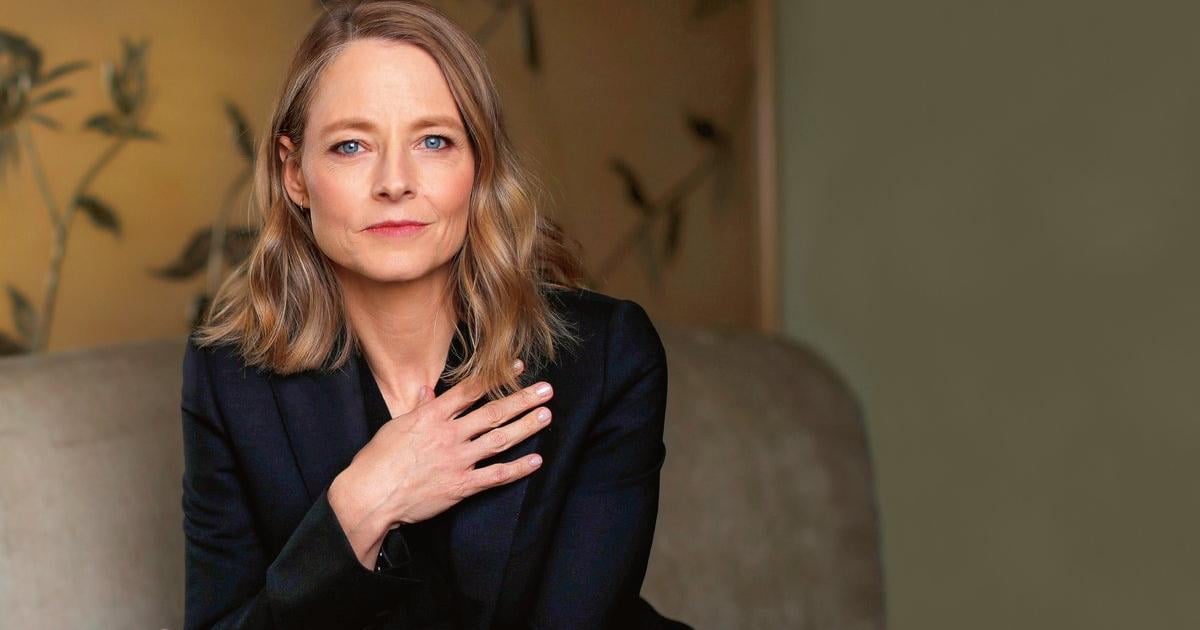
Taxi Driver (1976)
“I went to a private school, with the little Peter Pan collar, and I remember being really embarrassed having to wear those outfits. But it was the first time I had been asked to play a character that was not me in any way. Robert De Niro really taught me; he sat with me for hours to get me so comfortable with the dialogue I could go seamlessly in and out of improvisation. I thought acting was a dumb job up till then, but I realized that it was me not bringing enough to it.”
The Accused (1988)
“They definitely didn’t want me at first. I wasn’t at a popular place in my career. But director Jonathan Kaplan fought hard for what I brought, which was a toughness they were hoping not to have. I’m not tough — people think I am. But she was, and that drew me to her. … The hardest thing was that I felt I wasn’t giving them the performance everybody was hoping for. I wasn’t being a good girl and giving them what they wanted. And now I see that as a great strength.”
The Silence of the Lambs (1991)
“Lots of people ask, “How do you play strong and moving at the same time?” Well, they can do some of the things I can’t do, but that is something I can do. My head doesn’t stop working just because I’m acting. I have a specific approach that is just different from other people, more of an intellectual approach, and yet I am able to turn that into something emotional.”
Little Man Tate (1991)
“The casting was crucial. I saw hundreds and hundreds of kids; we ended up with one who had never even done a school play. The boy in Little Man Tate [Adam Hann-Byrd] is very close to who I was and who I am, feeling like I had to choose between my intellectual side and this very deeply emotional side and wanting both and trying to bring them together.”
Panic Room (2002)
“I just love [co-star] Kristen Stewart, but I didn’t think she’d choose to be an actress. I said to her mom, “She doesn’t want that, right?” And she’s like, “Well, yes, she kind of does.” Because she’s very much like me: She’s not comfortable in life being a big, externally emotional person, beating her chest, crying every five minutes. I felt she was such an intelligent technician, so interested in camera — I thought that would translate to other things.”
